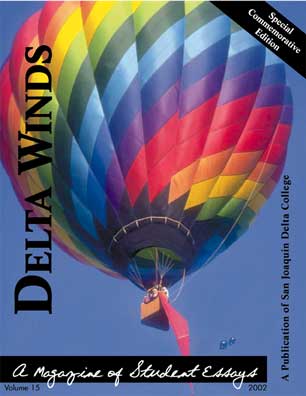Editors' Choice: Racism and Sexism in Advertising
 Delta Winds: A Magazine of Student Essays
Delta Winds: A Magazine of Student Essays
A Publication of San Joaquin Delta College
2002
Editors' Choice: Racism and Sexism in Advertising
(Originally published in 1997 in Delta Winds Volume 10)
Shafeeq Sadiq
It seems as if everywhere you turn, someone is trying to be politically correct. Whether it involves minorities or women, racist and sexist comments are no longer tolerated in places such as the school yard and the work place. Why is it, then, that minorities and women are constantly being exploited in everyday advertisements? Television, magazines, and billboards no longer show products, but rather show gimmicks in order to sell their product. In general, these gimmicks seem to enforce racial stereotypes and to view women in a negative way. It appears that on every channel, there is another television commercial trying to sell its product with beautiful women. These commercials can range from selling beer to selling cars.
Who can forget the gorgeous blonde standing next to the green Geo Storm, proudly exclaiming, "A man likes a woman who knows how to drive a stick!"? Advertisements like these, though seemingly aimed towards women, are actually exploiting them en route to their actual target: men. This commercial would routinely air during sporting events, when the majority of the viewers are male. It fits in well with the other commercials which, more often than not, have to do with beer.
Beer companies have been notorious for exploiting women in their everyday promotions. Watching a football game, you can usually find an attractive young lady being swept off her feet by a less than attractive man after he opens the beer of his choice. Or, if you are lucky, you can witness several young women materialize on a desert island with the male drinker after, of course, he opens his can of beer. These advertisements present women as a goal, a trophy if you will, that can only be attained with the proper beverage. These women seldom have anything to say besides "Yes," making them seem like unintelligent sex objects. Unfortunately, the exploitation does not stop with women. Beer commercials exploit minorities as well.
Black Entertainment Television frequently airs malt liquor commercials directed at African-American buyers. These usually involve a hip-hop rap artist who visits an unusually quiet ghetto community. When he brings the malt liquor, the entire neighborhood breaks into song and dance, with the very attractive African-American woman saying, "Things are back to the way they used to be." How did things used to be? Were there no peaceful afternoons in the 'hood? African-Americans can't be happy in a calm, serene environment? Though there are no racial slurs uttered, the entire commercial perpetuates stereotypes of the African-American community. They must sing and dance in the streets, trying to live life the way it used to be, before they were confined to the monotony of a good job and a quiet neighborhood. Perhaps the commercial maker is trying to say that African-Americans, as a whole, have been subdued by society.
African-Americans are not the only minority group exploited in advertising; Arab-Americans are victims as well. On September 16, 1996, Newsweek magazine printed a two page advertisement for a well-known computer company. This ad depicted an Arab man from an unknown Arab country, wearing his native garb and standing next to a camel. There are boxes of computer parts in the corner of the page. The ad reads: "Some computer companies don't make their own parts. Makes you wonder where they get them." This advertisement insinuates that if these parts were made in an Arab country, they would somehow be inferior. Though the country is not mentioned by name, the message is still very clear.
Perhaps the most stereotyped people, when it comes to advertising, are Indian-Americans. To my recollection, there has never been a major commercial involving an Indian-American who didn't speak with a ridiculously exaggerated accent. The most recent perpetrator, MCI, promotes a dime-a-minute service featuring an Indian-American with a very thick and pronounced accent stereotypically driving a New York City taxicab. The actor will never be an American who happens to be of Indian descent. For the company, using Indian-Americans in this manner might add to the comic value of the commercial. But it is safe to say that to most Indian-Americans, it is no laughing matter.
Racism and sexism are problems that go unnoticed in advertising today. Nevertheless, they must be dealt with. The only winners in these types of ads are the advertisers themselves, who make money when you buy the product. There needs to be a public awakening, for racism and sexism should not be used in any situation, especially not to sell products. Advertisers need to take responsibility for their own actions and to end this type of exploitation. If they do not, we the consumer can always force them. After all, we have the dollars and the sense.






